13 Mistakes Everyone Makes With Homemade Hot Chocolate
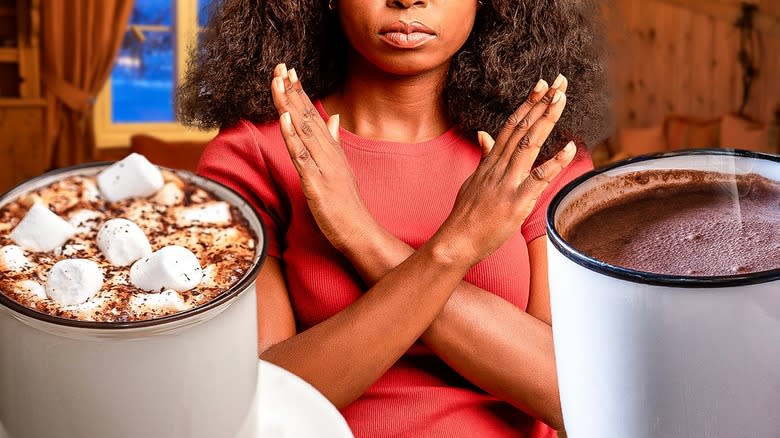
Only one thing can make cozying up by the fire with a good book and festive vibes even more enjoyable and relaxing: a nice, warm cup of hot chocolate. Whether you call it hot chocolate, hot cocoa, or some personal iteration in between, you know it and love it. While it may, in theory, be one of the easiest drinks to whip up at home, there are some pitfalls to navigate, as well as an array of options for improving the drink. And choosing not to engage in some of those hot chocolate upgrades is a mistake in itself.
Sure, you can use hot water from your Keurig poured over a mug filled with a packet of hot chocolate powder, stir it together, and call it a day. But we think you deserve better. That's why we put together this comprehensive list of mistakes that everyone makes when concocting homemade chocolate. Now, you can avoid the errors and take your cozy hot chocolate game to the next level. What's more in the spirit of the season than that?
Read more: 26 Coffee Hacks You Need To Know For A Better Cup
Choosing Water Instead Of Milk
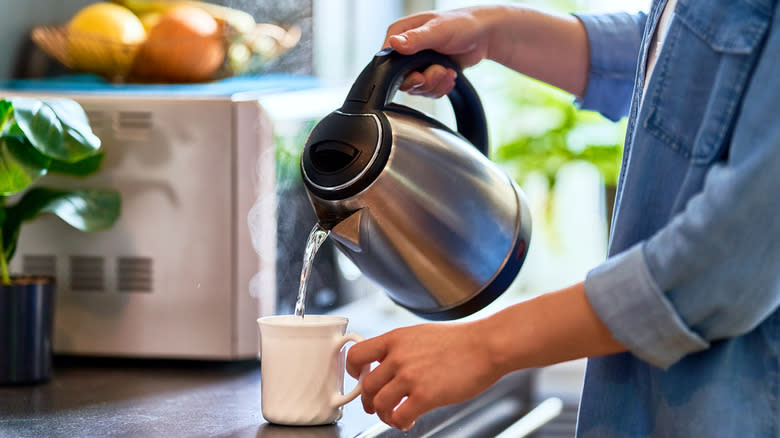
It is somehow an option to make your homemade hot chocolate with water instead of milk. We think this is an egregious error that you should avoid at all costs. However, we do have sympathy. Sometimes you just don't feel like warming up ice-cold milk from the fridge. Other times you're simply out of milk and can't be bothered to make a trip to the store. And some of the most relaxed folks among us will simply be content to use water in their hot chocolate and claim to not taste any difference (we know they're either lying or kidding themselves, of course). So, if you're one of those people who purposefully and consistently choose to make hot chocolate with water instead of milk to try and annoy the hot chocolate-made-with-milk lovers, you're only hurting yourself.
If you're in the predicament where you received some hot chocolate Keurig K-cups and don't want them to go to waste, but also don't want to use water in your drink, at least make a half-and-half situation work. Click one of the smaller sizes on your machine, warm up some milk, and then fill the rest of the mug with it. It'll at least be creamier and less, well, watery than a pure water base. We're here for hot chocolate, not for chocolate-flavored water.
Picking A Less Creamy Milk

Since milk over water is the only rational way to do things, it's time to decide which type of milk you should use. If you already have your preferred milk type of choice in your fridge, we don't see a reason to go to the store just to get a thing of milk specifically for your cup of hot chocolate. But if you're already out shopping and have been dreaming of this quintessential holiday tradition, we have some pro tips for the best types of milk you could get.
First, we think the creamier the milk, the better. It's because it's the same principle that applies to using water in hot chocolate: When you use something like skim milk in hot chocolate, it doesn't have a lot of creaminess or create that lush mouthfeel we all love with quality hot chocolate. Now, again, if skim milk is all you have, it's lightyears ahead of using water. But it's still just not as good as a creamier type of milk. Go for at least 2% milk, though whole milk will taste best. In the plant-based milk realm, we think oat milk works wonderfully, as does any barista-blend milk, as those tend to be much thicker and creamier.
Not Heating Up The Milk
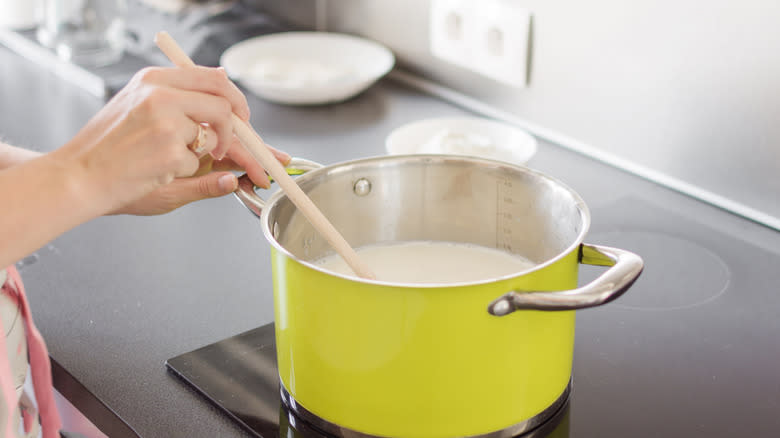
We're really putting together the building blocks here, people. Now that you've wisely chosen a creamy, quality milk to use, you obviously have to heat it up somehow. Just dumping the cold or room temperature milk into your mug and adding your chocolate will make you an iced hot chocolate. Yes, that sounds like an oxymoron, but that is actually a common drink you'll find on cafe menus. If you're aiming for iced hot chocolate, that's fine, but it's the coziest time of the year, so let's delve into what a traditional, warm, hot chocolate requires with milk.
There are a few different ways and techniques you can call upon to warm up your milk. The first and most obvious is by filling your mug with your milk of choice and putting it in the microwave. This works fine if you want a fast solution but be wary of potential splashing in your microwave, as well as the handle of your mug being incredibly hot to the touch. Our preferred way is heating it on the stove in a small pot. That way, the milk gets heated up evenly, with no opportunity for cold patches.
Curdling The Milk

There's another potential mistake you want to avoid in the process of warming hot chocolate: curdling the milk. If you're not too sure what curdling milk is and why it's a truly unfortunate mistake to make, here's the rundown. Milk curdles when getting hot to the point of boiling, and when this happens, the proteins in the drink separate from the liquids, creating clumps of dairy in your liquid, essentially. It's a much grosser form of cottage cheese, to give you a visual. Obviously, nobody wants to drink this, as it's quite disgusting.
So when you are warming your milk for your hot chocolate, make sure it's not getting heated to the point that curdling can occur. If it does curdle, it's best to just throw it out and start over. Always be sure to give your warm milk a stir after heating it up to double-check before combining it with your chocolate. It's better to find out that it's ruined before taking a nasty sip of it.
Selecting A Low-Quality Chocolate Powder
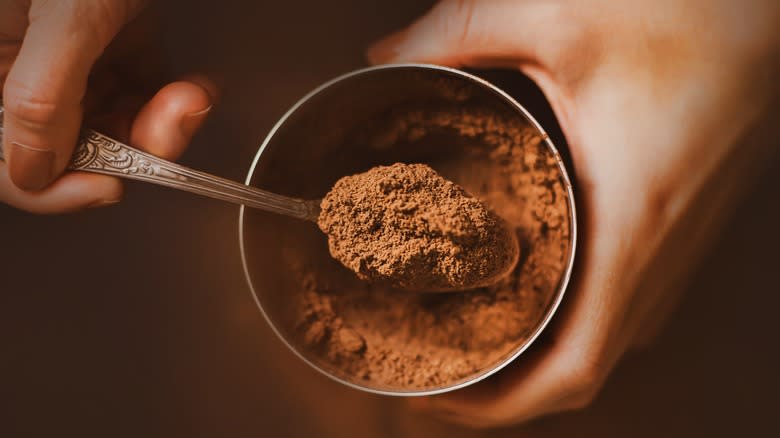
You're doing great so far, folks. You've selected your favorite milk, heated it up (without curdling it), and now is the time to incorporate your chocolate. If you choose to go the powder route, you may just choose whatever random hot chocolate powder you have waiting in the back of your cabinet for your rare cup of winter hot chocolate. That's fine, but if you want a top-quality experience, you need to indulge in a higher-quality chocolate powder.
Luckily, we've taken the time at Tasting Table to personally taste-test and rank various popular hot chocolate powders (or mixes, same difference, different name). In our findings, we discovered that the absolute best hot cocoa mix was from the Jacques Torres brand, with Lake Champlain, French Broad, and Ghirardelli brands following close behind. Any one of those will be a winner in your ultimate cup of hot cocoa.
Under-Mixing The Milk And Powder
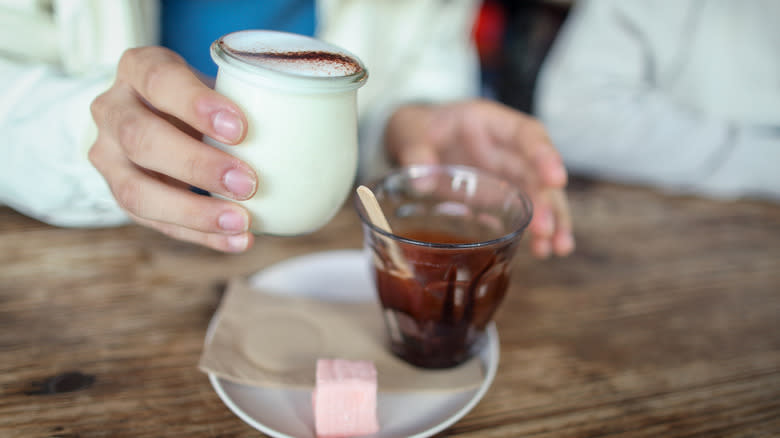
After heating your milk and selecting an elite hot cocoa powder, it's time to mix the two. But a pitfall we see all too often? Under-mixing the milk and hot chocolate powder. It completely ruins your drink when you finish with chunks of chocolate powder at the bottom of your mug. And while it can be indulgent and reminiscent of childhood to take a spoon and scrape those bad boys out of the bottom of your mug and eat them, it's not exactly the refined, sitting-by-the-fire hot chocolate experience we're aiming for. Plus, it means that your drink wasn't as chocolatey as it could've been, having many floaters sink instead of getting incorporated into the drink.
There are different ways you can mix your warm milk and hot cocoa powder, the first of which is classic. Pour the powder into the warm milk and stir it. This, however, is what typically leads to the chunky unincorporated mess we're attempting to steer you away from. You can put the powder in the mug first before putting the milk in there. That way, the milk warms at the same time it mixes with the powder, making it easier to stir it all together. You can also put the powder in the pot on the stove with the milk to heat up, which would achieve the same effect, just at a more consistent level.
Thinking Hot Chocolate Powder Is Your Only Option
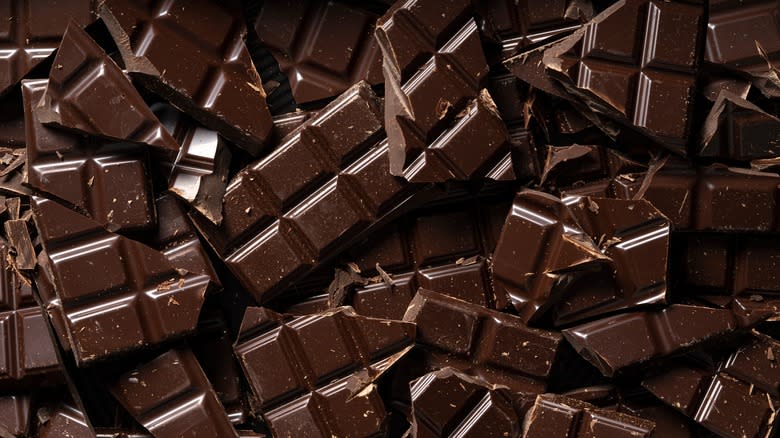
And now it's time to delve into the other options you have in terms of chocolate in your drink. You didn't think the most delicious hot chocolates in the world use powder as their base, did you? Well, you don't have to, either. It's time to level up.
While we don't have anything against using hot chocolate powder, it doesn't make the quintessential cup of cocoa. You can use any type of chocolate you want in your beverage. If you're a dark chocolate person through and through, nothing is stopping you from using 80% dark chocolate and having the most bitter hot chocolate ever made. If you want to switch things up, go for a white chocolate base with a chocolate whipped cream for a flavor-swapped hot chocolate. And, of course, you can always go for milk chocolate as your most classic base.
Melting Your Chocolate In The Microwave
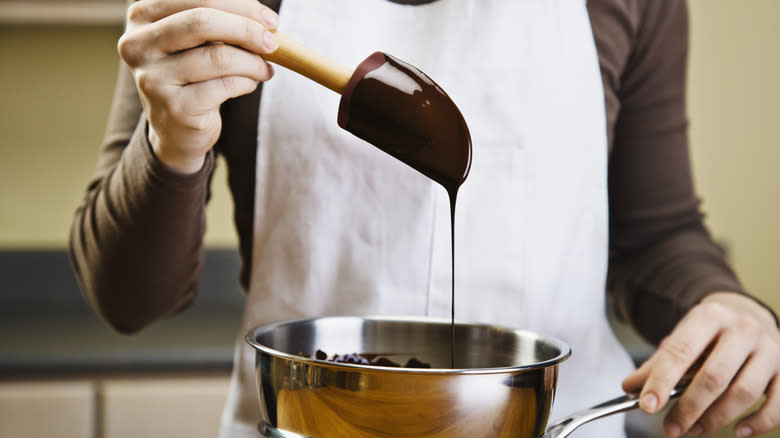
If you haven't dabbled in different chocolate melting techniques, you might not be aware that there are better ways to melt your chocolate than in the microwave. The reason melting your hot chocolate chocolate in the microwave is a mistake is that it gets very hot, very fast, and it doesn't melt the chocolate as evenly as other methods. If, like heating up your milk for the drink, the microwave is your easiest option, and your goal is to drink your hot cocoa as fast as possible rather than making it as tasty as possible, then microwave away. But if you wish to make your holiday extra special, try these other chocolate melting methods.
We recommend the double broiler method (pictured above), which just involves putting your chocolate in a pot overtop of boiling water, and the steam will evenly melt your chocolate as you stir it. No matter how you choose to melt your chocolate, make sure to chop it up into small, even pieces first. That way, it melts faster and evenly, which is what you want in a smooth cup of hot cocoa.
Having Milk Chocolate Be Your Only Flavor

Whether you're running with hot chocolate powder or actual melted chocolate as your base for your drink, that shouldn't be the only flavor in there. In fact, you can go to town with the types of flavors you incorporate into your drink. Are you looking for a seasonal twist? Mix peppermint, eggnog, or even gingerbread into your hot chocolate recipe. Do you love spicy food? It can't hurt to try a Mexican hot chocolate and add some spices to heat things up in a different way.
Be sure to err on the side of caution when adding your supplemental flavors in, though, since it's always easier to add things in, not take them out. For instance, if you want to make a cinnamon hot chocolate, start by stirring in just a sprinkle, rather than a whole teaspoon. Taste-test it to see how you like the ratios, then proceed from there. Especially with strong flavors like flavored syrups you would use in coffee (vanilla or caramel flavor, for instance), go with one pump first, stir it around, and adjust as desired.
Using Stale Marshmallows From Last Year

Opening the pantry door, reaching your hand toward the long-forgotten back of a shelf, and dusting off your jar of marshmallows from last year might be fine, but there's also a good chance it's not. Don't let stale marshmallows be your Ghost of Christmas Past this year, and instead let this article be a Ghost of Christmas Future: Before assuming your marshmallows are still good, check them. That way, you can add some fresh marshmallows to your grocery list before making your hot chocolate, instead of being disappointed you didn't have the foresight to check the freshness of last year's white puffs. And if you're unsure whether your marshmallows are still good or not, give them a smell taste, a texture test (are they hard as a rock, or still fluffy?), and if you're still unsure, give them a small taste test.
Or, you could take it up a notch during the festive season and make marshmallows at home. It's way easier than it seems, and you just need granulated sugar, corn syrup, vanilla bean paste, salt, powdered sugar, and any additional extracts you might want to use to flavor the marshmallows.
Not Being Creative With Your Toppings

Marshmallows are classic, of course, and widely beloved for a reason — they're delicious. But if you've spent every holiday season with the same old hot chocolate toppings, it can't hurt to switch things up a bit this year. First, keeping with the marshmallow route, if you want to make your own marshmallows, you don't have to make them plain vanilla, nor do you have to make them into simple box shapes. Flavor-wise, you can have a merry and bright time with things and match your marshmallow flavor to your hot chocolate base flavor. For instance, if you went for a cinnamon hot chocolate base, why not make some complementary maple cinnamon marshmallows to pair with it? Or if you're a peppermint lover, go for a dark chocolate hot chocolate base with peppermint marshmallows. Next, in terms of marshmallows, shape them into whatever shape you want when making them. Go for a snowflake, a snowman, or even try something more advanced: dye it green, and shape it like the Grinch.
If you're looking to branch out even beyond marshmallows, top your hot chocolate with, well, anything. Bits of pretzel, M&Ms, mini chocolate chips, crushed candy cane, crushed-up Oreos, gingerbread men, and anything sweet can make for tasty toppings.
Forgetting You Can Spike It

If you're able to legally indulge in a drink or two, how about a spiked hot chocolate? Though it may not be at the top of your holiday list, like spiked eggnog or a cranberry-based martini, it's just as (if not more, to be honest) delicious. We find that this works best with richer hot chocolates, like the ones with real melted chocolate and the creamiest milk you can find. That way, the creaminess masks the alcohol a bit more than a simple water and hot chocolate mix powder would.
As for what you could pour into your hot cocoa, we have a few ideas. If you're going with the Mexican hot chocolate, tequila seems quite fitting to add. If you're a coconut milk lover, take your coconut milk-based hot cocoa to the next level with some coconut rum. And if you just want a traditional hot chocolate, Kahlua is your best bet for spiked hot cocoa this holiday season.
Keeping It Too Traditional
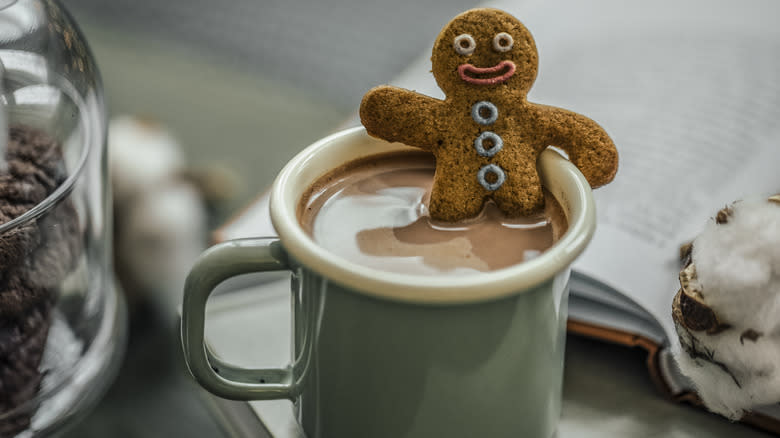
Reach ultimate hot chocolate lover status by going far out of the traditional American hot chocolate box. There are so many hot chocolate variations out there that you could create a new combination for every day in December, but here are a few more creative and international ideas for you to try out.
In Colombia, cheese is a star ingredient in hot chocolate. If you're wondering how that flavor combination works, Colombian hot cocoa lovers use a 100% cacao bar as their chocolate base, so it's incredibly bitter. Combined with a soft white cheese called queso campesino, which melts faster than you can say ho ho ho, and milk, it creates a perfectly sweet and salty beverage. Salted caramel lovers will probably enjoy this drink. Another international type of hot chocolate you can sample this year is Argentinian hot chocolate. You have to use Aguila chocolate bars for this for the best experience (they're very rich dark chocolate bars) and do as the Argentinians do with this recipe by serving your hot milk in a cup with the chocolate bar on the side. Dump the chocolate in when you're ready to drink it and stir it up, making it the freshest version of the drink.
Read the original article on Tasting Table.